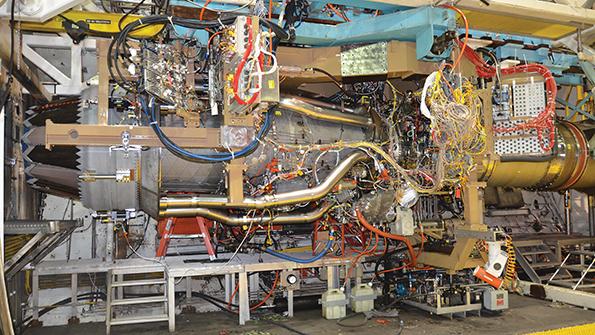Budget Shows Flightworthy Sixth-Generation Fighter Engines Ready By 2025

Details of the first of two mostly secret initiatives to support the U.S. Air Force’s five-year-old pursuit of a sixth-generation successor to the Lockheed Martin F-22 are now released and reveal that a critical technology for the Next-Generation Air Dominance program could become flightworthy by mid-2025.
GE Aviation and Pratt & Whitney are scheduled to complete separate competitive designs for a Next-Generation Adaptive Propulsion (NGAP) system by the second quarter of 2022 and finish assessments on a full-scale engine three years later, according to Air Force budget documents.
- Fighter X-planes funded since 2015
- Adaptive engines available by 2025
The schedule and spending details on the NGAP appeared for the first time in the Air Force’s budget justification documents for fiscal 2021 that were submitted to Congress in February, but passed unnoticed for several months. The Air Force awarded GE and Pratt each a $427 million contract to support the NGAP program, but the details were shrouded in budget documents within the related Adaptive Engine Transition Program (AETP), an unclassified effort to develop a reengining candidate for the Lockheed F-35.
After Senate authorizers cited the Air Force’s lack of transparency for justifying a $270 million budget cut for AETP this year, service officials decided to break out funding for the NGAP in budget documents.
In fact, the NGAP program reappeared in the fiscal 2021 budget documents for the first time in more than six years. The Air Force has kept all details about the Next-Generation Air Dominance (NGAD) program highly secret since 2016, but there was a brief, two-year window in 2014-15 when senior defense officials provided information about the underlying technology development efforts.
The NGAP was first referenced in testimony by Alan Shaffer before House Armed Services Committee in March 2014. Shaffer is now the deputy to Ellen Lord, undersecretary of defense for acquisition and sustainment. Six years ago, he was the principal deputy to the director for research and engineering. In that role, Shaffer introduced the NGAP as an enabler to the NGAD program, along with another, complementary initiative focused on new airframes.
“This program will develop and fly two X-plane prototypes that demonstrate advanced technologies for future aircraft,” Shaffer said in 2014. “Teams will compete to produce the X-plane prototypes, one focused on future Navy operational capabilities, and the other on future Air Force operational capabilities.”
A year later, Frank Kendall, then undersecretary of defense for acquisition, technology and logistics, elaborated on the Aerospace Innovation Initiative (AII). The development of the X-planes would be led by DARPA, he said.
“To be competitive, the Navy and the Air Force each will have variants focused on their mission requirements,” Kendall said. “There will be a technology period leading up to development of the prototypes. This will lead to the systems that ultimately will come after the F-35.”
The results of the AII program have not been released or even acknowledged by Air Force or defense officials since 2015, but the initiative suggests that one or two X-plane aircraft could be in testing now.
Kendall’s remarks to Congress in 2015 came a year before the Air Force received the results of an Enterprise Capability Collaboration Team on the Air Superiority 2030 Flight Plan, which urged the development of a family of systems anchored by a next-generation fighter to replace the F-22. The Flight Plan prompted the Air Force to commission an analysis of alternatives (AoA) in late 2016. The results of that study were originally scheduled to be released by the end of 2017, but the analysis continued until early 2019.
Meanwhile, a 2015 presentation by the Air Force Research Laboratory showed a notional schedule for the NGAD program; a contract award to launch the engineering and manufacturing development (EMD) phase is set for fiscal 2023. As late as the Air Force’s fiscal 2019 budget request, the financial resources devoted to the NGAD appeared to support that schedule: A significant increase in funding starts in fiscal 2023, and $13 billion is set aside overall between fiscal 2019 and 2023. Last year, however, as the results of the AoA study became available, the Air Force appeared to defer the launch of the EMD by at least a few years. The fiscal 2020 budget request included only $6.6 billion for the NGAD from fiscal 2020-24.
Funding for the NGAD and NGAP programs is accounted for separately in Air Force budget documents. The fiscal 2021 budget justification documents reveal that the Air Force spent $106 million for the NGAP in fiscal 2019. Another $224 million is allocated to the NGAP this year. But the program has requested an additional $403 million in fiscal 2021, the budget documents show.
“The Next-Generation Adaptive Propulsion effort consists of four phases: preliminary design, detailed design, engine fabrication and engine assessments,” the Air Force’s budget documents state.
“Program deliverables include military adaptive engine detailed design parameters and models, engine hardware (plus spare parts), matured technologies, major rig assessment data (controls, combustor, etc.), program reviews, and technology, affordability and sustainability studies for next generation fighter aircraft,” the documents add.





